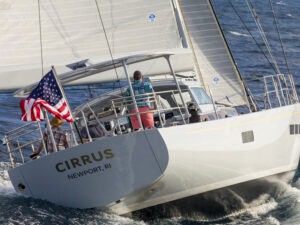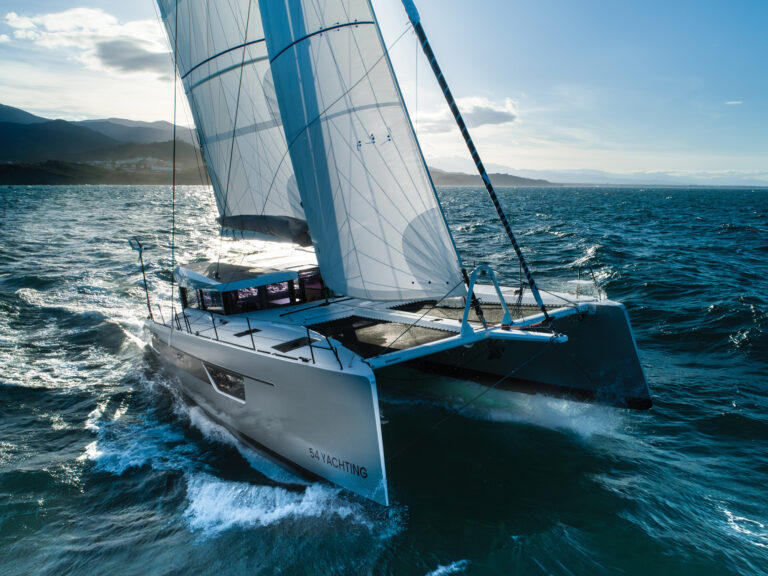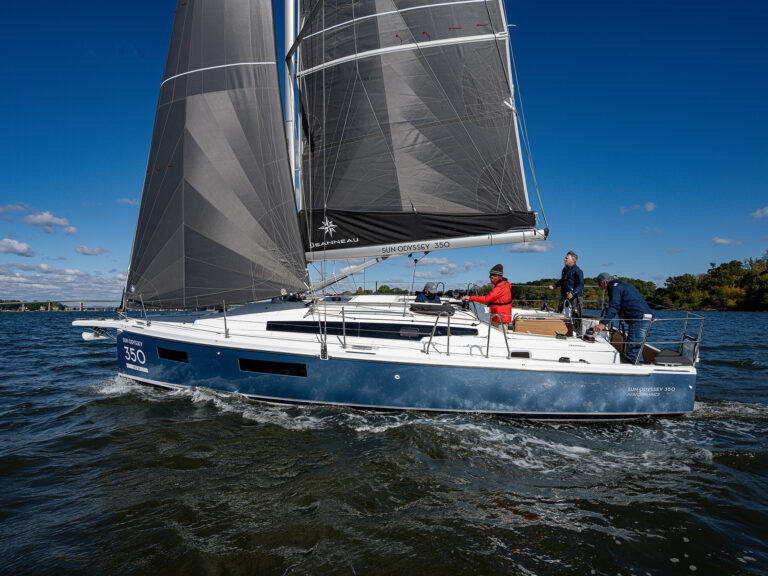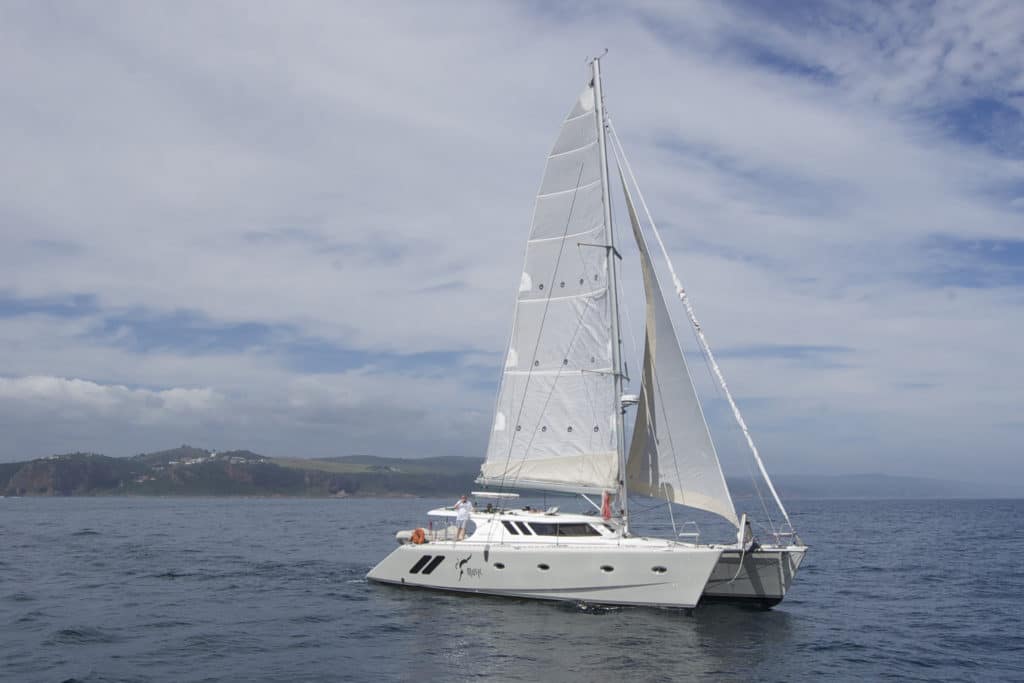
The warm Agulhas Current puts our Gulf Stream to shame. Flowing southbound out of the Indian Ocean and down through the Mozambique Channel, it attains an astonishing 6 knots by the time it crowds in close to the craggy South African coast. Beyond that current lie the Roaring 40s and the Southern Ocean, and beyond them, Antarctica. Three ocean systems, very warm and very cold, clash here, spinning off a regular train of gales that come crashing into the current.
Several years ago, Duncan Lethbridge was delivering one of his new St. Francis 50 catamarans along South Africa’s Wild Coast with a novice crew as one of these recurring blows was building up. He handed over the helm to get some rest, leaving clear instructions to stay in close to shore and out of the current. When he came back on deck a couple of hours later, he knew straightaway what had happened, and it didn’t take long for conditions to deteriorate. “The seas were four stories tall,” Duncan told me, “and the top two stories were collapsing.” They’d strayed into the current. For the next many hours, he said, he had to use every steering skill he’d learned sailing Hobie Cats through the beach surf in Jeffreys Bay to stay upright and sailing — except now he was doing it at sea in a 12-ton catamaran.
Duncan founded St. Francis Marine in 1988, and he stands as a godfather of today’s South African boatbuilders. When St. Francis shifted production from 44-footers to 50-footers in the early 2000s, Duncan sold his tooling for the 44s to Kevin Fouche, who used it to start Knysna Yacht Co. Rudi Pretorius ordered a Knysna 440 for his family and loved the build process so much that five years later he became a boatbuilder himself, starting Maverick Yachts in 2007. Meanwhile Kevin’s neighbors at Vision Yachts built a 45-foot cat from tooling created by Peter Wehrley at Matrix Yachts. In fact, the more you talk with South African boatbuilders — the Paarman brothers at Nexus Yachts, Tim van der Steene at Tag Yachts, Mark Delaney at Two Oceans Marine Manufacturing — the more you understand that the whole industry is a network of interconnected relationships, both within companies and between them.
Collectively, South Africa produces 30 percent of all the cruising multihulls in the world, second only to France. Yet the business models prevailing in the two countries could hardly be more different. With the exception of Robertson and Caine, which will build 175 boats this year at four separate plants near Cape Town, the South African builders produce just a handful of yachts each: four boats, eight boats, 12 boats a year. These are typically family businesses operating not as high-output factories but as artisan shops. And without exception, each of these mom-and-pop enterprises is run by very good sailors, many of whom started their company out of the desire to build a single cruising boat for themselves. Several of these builders spent years as full-time cruisers or charter skippers. Most have taken boats across oceans. Each is a veteran of the Cape of Storms.
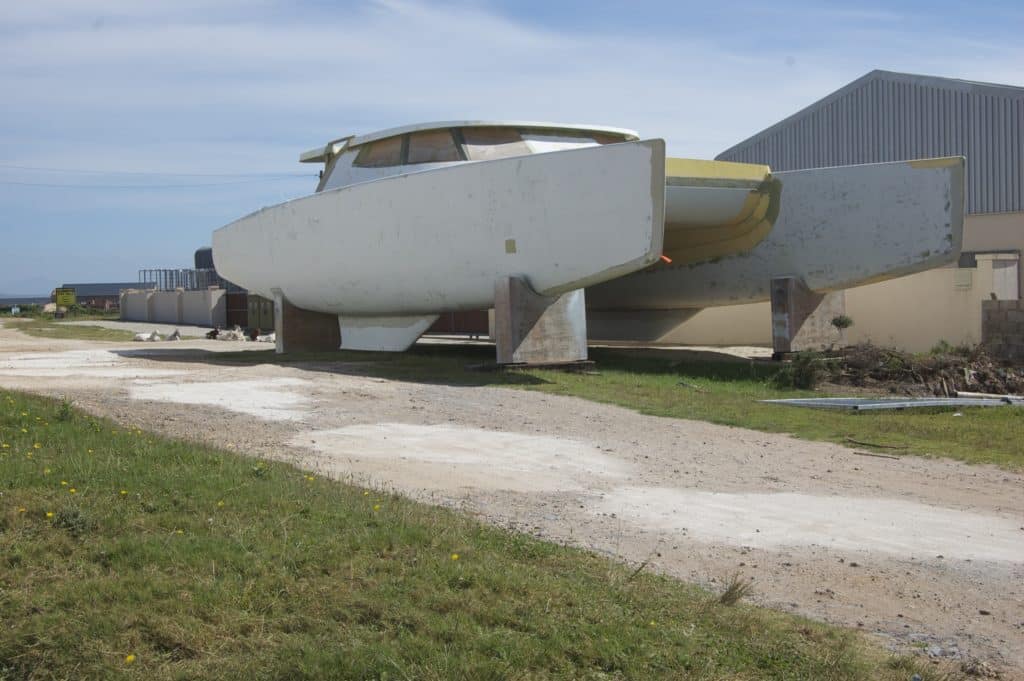
A Boatbuilding Country
Last December I traveled to Cape Town and the Eastern Cape to meet South African boatbuilders, tour their yards, and sail some catamarans. What I found surprised me: If the business models hearken back to an earlier time, the technology from which many of the boats are built looks distinctly forward. Among this group, I saw some of the lightest, stiffest, highest-tech sailboat structures available anywhere in the world. If you’re in the market for a new cruising cat, it’s a trip I recommend. Knysna Yachts’ Kevin Fouche recommends it too; he says he’ll even reimburse the travel costs of anyone who comes to visit his yard and places an order for a boat. With the rand, or ZAR, at historic lows against the dollar (at press time, U.S. $1 buys more than 15 rand), that’s an arrangement you might be able to negotiate with other builders as well.
Cape Town is the undisputed hub of South African boatbuilding. The big marine chandleries and materials suppliers are here, as are the sailmakers and riggers and boatyard crews. Other boatbuilding pockets lie farther east, past Cape Agulhas — the true southern point of Africa, and the boundary between the Atlantic and Indian oceans — and then along the Garden Route and Eastern Cape coastlines, particularly around St. Francis Bay and Knysna. Die-hard surfers are drawn to Cape St. Francis for the “10 million-to-1” waves at Jeffreys Bay, made legendary by the 1966 documentary The Endless Summer. Idyllic Knysna, with its vast lagoon and dramatic oceanfront cliffs, is a gateway to several renowned big-game reserves. The drive from Cape Town is about five hours to Knysna or seven and a half hours to St. Francis Bay, and the ride itself, through national parks and along the coast, is worth the time. Twice on the N2 national highway, I had to slow my rental car to let baboons cross, and a detour to the penguin colony at Simon’s Town is one I’ll never forget.
As for Cape Town, orienting yourself is easy. Take the funicular to the top of Table Mountain on a clear day, and you’ll see the whole region laid out before you. To the south stretches Cape Peninsula and some 50 miles to the Cape of Good Hope, as the Cape of Storms is known on modern charts, much of it national park that offers spectacular hiking and cycling. To the southwest lie Hout Bay and the modernist beach neighborhoods of Llandudno, Camps Bay, Clifton and Sea Point. Out west across Table Bay, 8 miles off, lies Robben Island, the prison where Nelson Mandela spent 18 years of his sentence, now a UNESCO World Heritage site. Spread out just below are the city center and the Victoria & Alfred Waterfront, where Cape Town’s marine services mix with high-end shopping and entertainment. And northwest of these, out near Table Bay’s western strand and the industrial zones of Woodstock and Montague Gardens and Atlantis, lies the real interest: Here is where the boats get built.
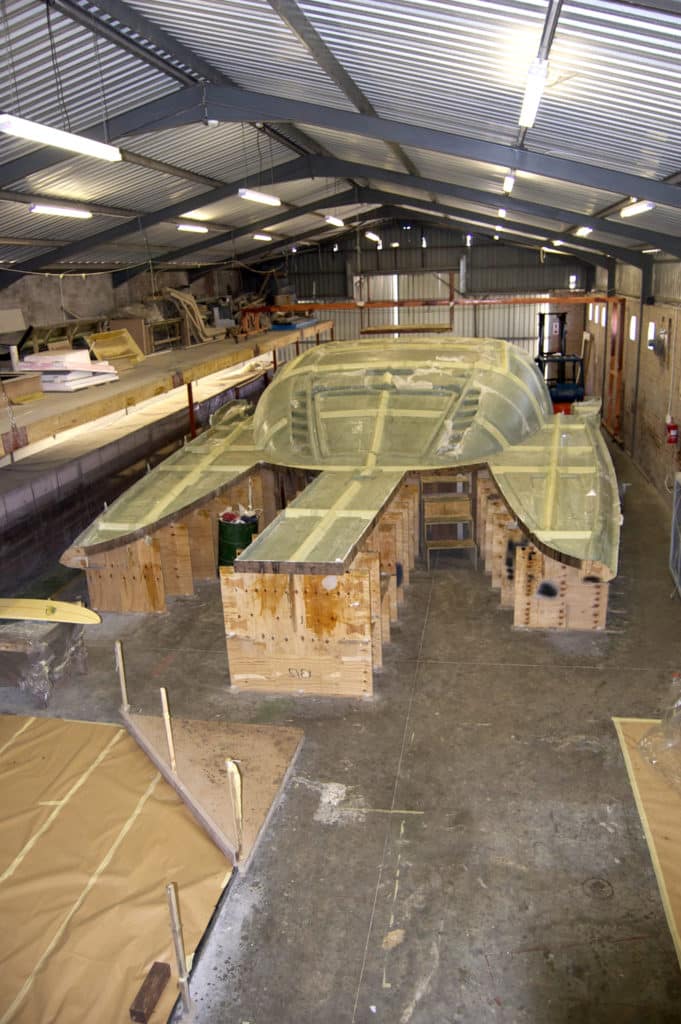
Why Build Boats in South Africa?
South Africa’s business climate differs in some ways from the climate in North American and European countries, and in other ways from the climate in Latin American and Asian countries. Three forces shape any business environment: labor markets, government regulation, and procurement of materials and components.
South Africa’s blend of these forces is unique. When Rudi Pretorius examines the costs in a new Maverick 440, this is what he sees: components, 35 percent; raw materials, 19 percent; labor, 14 percent; overhead, 17 percent; and tooling, 15 percent. The big-ticket items are not labor or real estate or marketing, but components and equipment that come in from abroad. “If you were in Australia,” said Rudi, “labor would have been much, much higher.”
Phil Berman, of the Philadelphia-based Multihull Co., conceived the broad outlines of the Balance 526 performance-cruising catamaran, then commissioned Cape Town yacht designer Anton du Toit to design it and Nexus Yachts of St. Francis Bay to build it. I met Phil in Cape Town for the launch of hull number one. Over the last decade or so, Phil has commissioned other new builds in Brazil and China. “The big advantage of South Africa over Brazil is procurement,” he said. “Cape Town has such a yacht-building facility that these guys can get what they need. We’ve got the Harken guys here. Southern Spars came to the boat to set up the rig. Ullman in Cape Town made the sails.” In Brazil, by contrast, “Everything had to be ordered six months out, shipped in and then trucked. So you have all this costly material, and it’s just sitting there.”
Interestingly, Rudi told me that Robertson and Caine’s high production scale inadvertently exerts an influence on the cost of components for all South African boatbuilders. “If I order a winch that’s on one of their boats, it’s a lot less expensive than one that isn’t,” he said.
South Africa’s most distinctive feature is its labor market: What skills are available, and at what cost? The legacy of apartheid and its aftermath fundamentally shape business here, creating both opportunities and constraints that are unlike those you’ll find elsewhere. Some of these factors take shape in government and industry programs; others are deeply rooted in ethnic culture. South Africa officially designates people according to race: Black African, Coloured (mixed race), White and so on. Through an official program called Black Economic Empowerment, based on score cards and created to redress the inequities of apartheid, the South African government formally grades each business on its degree of diversity.
Boatbuilding jobs are welcome in South Africa, as nationwide unemployment figures float around 25 percent. The going rate for an entry-level laminator, according to one Cape Town builder I interviewed, is 40 rand ($2.70) per hour; highly skilled workers earn 100 rand ($6.70) per hour. Assuming eight-hour days and 240 working days in the year, that amounts to annual salaries of between $5,000 and $13,000. By contrast, a recent study by the state of Maine showed the average marine-trades salary in that state to be just over $40,000.
As an industry, South African boatbuilders are working to develop the necessary trade skills among potential employees. Trade groups like the South African Boat Builders Export Council (SABBEX) and Marine Industry Association South Africa (MIASA) collaborate with False Bay College on a three-year yacht and boatbuilding program that combines six-month cycles of classroom work with equal intervals in apprenticeships. Every Cape Town yard I visited employed students from this program. Otherwise, each company trains its own staff.
“Virtually every one of our guys has been trained by us,” said Peter Wehrley of Matrix. “A lot of our guys had never been employed before. We generally start them at sweeper and see how they operate. Then, slowly but surely, we train them up. It’s actually quite rewarding to be part of the community.” Phil Berman compared his boatbuilding experiences in South Africa and China. “In China,” he said, “Lee [Xiangong] builds our boats. Lee went to a university of boatbuilding, but he isn’t a lifelong sailor. Lee is going to do exactly what I tell him to do.” In China, he said, communication took longer, and so it took longer to get projects done the way they wanted. And in South Africa?
“Jonathan [Paarman] isn’t going to do exactly what he’s told to do,” Phil said, laughing. “If he thinks something’s stupid, he’s going to let me know about it right away — because he’s a sailor. He intuitively knows.
“In South Africa,” he continued, “you have this core of South African build guys. There’s a culture. Guys like Jonathan, they don’t come along very often. And it takes a lifetime to get that kind of skill set.”
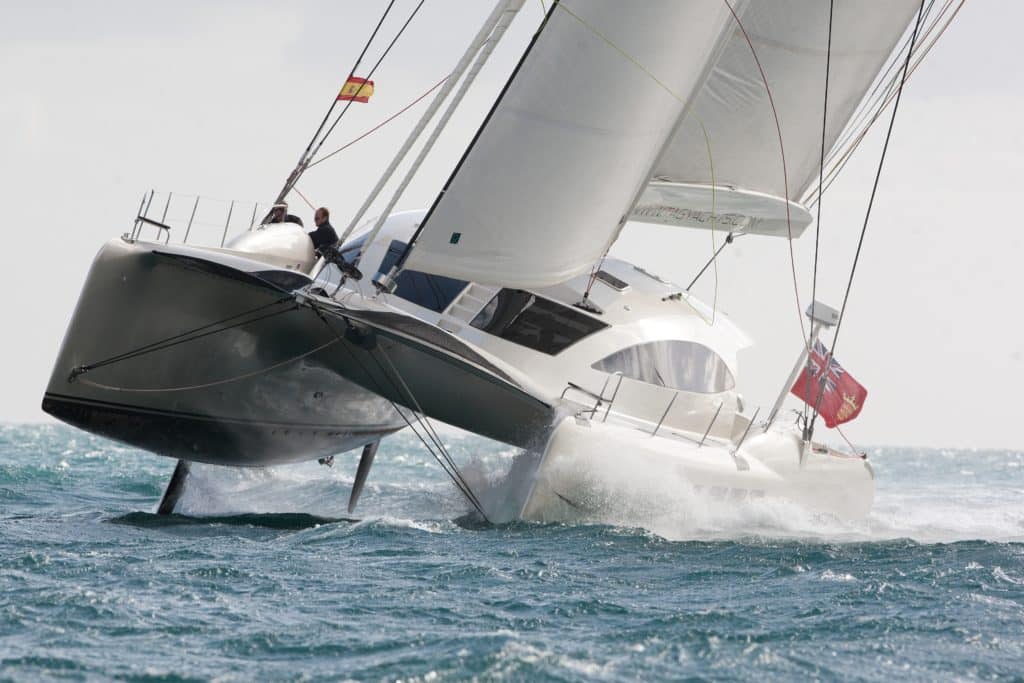
The Technical Spectrum
Fiber. Resin. Core. No matter who’s doing the work, the story of composite boatbuilding is the story of those three ingredients.
The simplest, lowest-tech way to build a boat is to lay out dry fiberglass (E-glass) in a female mold, then roll or spray catalyzed polyester resin into it and let it cure. “Hand-layup, solid construction” is the shorthand for this method. Since the late 1940s, it’s the predominant way that boats have been built.
“Sandwich construction” adds a core of foam or wood between fiberglass skins to attain the desired strength with less weight. Hand-laid construction has two potential downsides. For one, the fiber-to-resin ratio may vary widely from one day to the next: Too little resin compromises strength, while too much resin adds needless weight without adding strength. Secondly, in a sandwich construction, the bond between the fiber skins and the core depends entirely on what kind of day the laminator is having.
Vacuum-bagging is a method for evenly applying pressure on a laminate and then evenly distributing resin as it cures. This process starts out like hand-layup, but laminators cover the fiberglass, core and resin with an airtight film before the resin and bonding material cure. Then they submit the sandwich laminate to vacuum pressure. Consider that atmospheric pressure is 14.7 pounds per square inch. Over a span of one square foot, that works out to a ton of pressure. Core materials, whether foam or wood, start as flat panels that are scored on one side, allowing them to take on the complex shapes of a sailboat hull. Vacuum-bagging ensures that resin evenly covers the core’s surface and fills the spaces, called “kerfs,” that open up when core panels are bent. This is the method employed by Knysna Yachts, Matrix Yachts, Maverick Yachts, Nexus Yachts, Robertson and Caine, and Two Oceans.
Resin infusion is initially more involved and arguably riskier for the builder. How does it differ from vacuum-bagging? Resin infusion means laying up the fiber reinforcements and core, sealing the dry laminate under plastic, then drawing resin through the bagged laminate under vacuum pressure. Infusion is cleaner for the workers and better for the environment. Classified as a “closed-mold” technology, infusion significantly reduces styrene emissions during construction. Many builders in Europe and North America have adopted this method in order to meet government-imposed air-quality standards. For boat owners seeking high performance and low weight, infusion can offer the ideal fiber-to-resin ratio. Phoenix Marine, St. Francis Marine and Tag Yachts employ resin infusion in their hulls and decks. Other South African builders are beginning to infuse smaller parts.
Among resins, polyester has been the base line for 70 years. Vinylester is newer, more expensive and more resistant to osmosis. Epoxy’s properties are best, but it costs about four times as much as polyester and can be tricky to work with. Matrix Yachts builds its 760 model in polyester, then applies an epoxy barrier coat below the waterline. Knysna Yachts uses vinylester in the hull’s outer skin; St. Francis uses vinylester throughout the layup. Nexus, Tag and Two Oceans build their boats entirely of epoxy. To ensure that the epoxy cures fully, some builders post-cure the entire laminate after layup. “We put it in a tent and heat it up to 80 degrees Celsius,” said Mark Delaney of Two Oceans. “Then you ramp the temperature up slowly.”
“Exotic fibers” are those with better properties than E-glass. Of these, carbon offers exemplary stiffness per weight, though it’s several times more expensive than E-glass. Matrix, Tag and Two Oceans each offer all-carbon boats. They and Nexus also build boats with E-glass and carbon reinforcement for high-load areas.
Such deliberate use of materials and techniques delivers lighter, stronger boats. If high performance and low weight are what you’re after, the boats with the lower displacement-to-length ratios tend to be the ones employing the more advanced materials and techniques. The dollars-per-displacement column gives an idea of the premium placed on lighter weight.
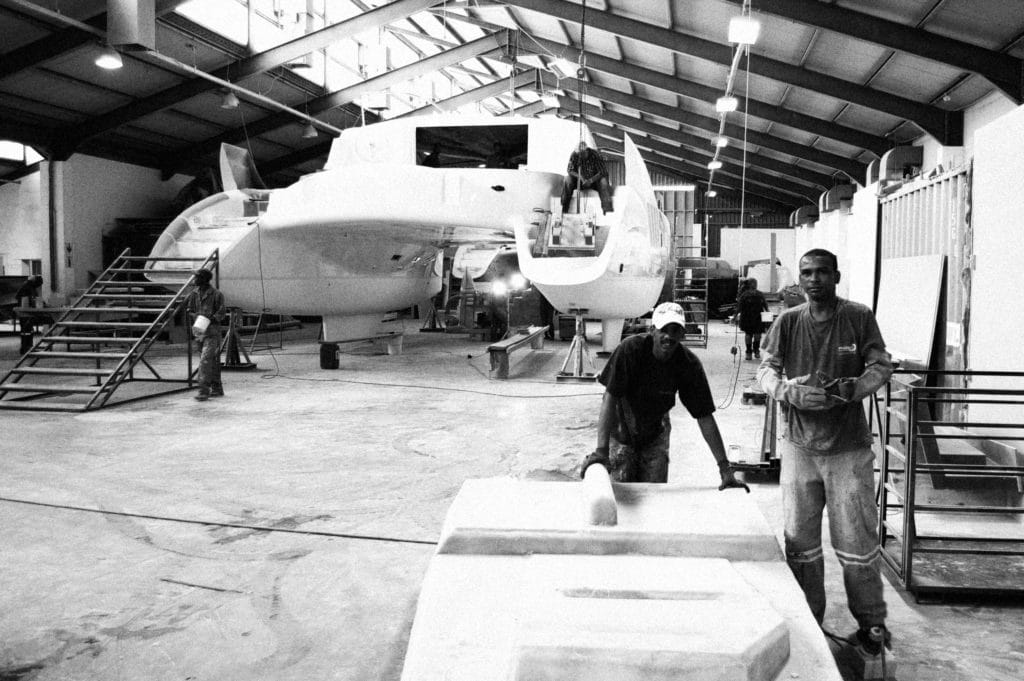
The Artisan Experience
South Africa’s blend of boatbuilding skills, maritime culture and labor rates distinguishes it from every other boatbuilding region. At the heart of that distinction lie the differences between high-production and artisan approaches. A 45-foot cruising cat from a high-volume yard might be built in around 5,000 man-hours, on assembly lines that employ advanced organizational techniques to reduce labor hours. Each boat designed for this high-volume business model must appeal to a broad demographic of sailors, which might include charterers.
By contrast, one South African builder told me his company invested 20,000 man-hours in a 40-footer; another estimated between 25,000 and 30,000 man-hours for a performance-oriented 50-footer.
Neither business model is clearly better or worse than the other. Rather, it’s a fundamental qualitative choice. There are advantages to owning a boat from a well-capitalized company whose practices over dozens or hundreds of units have been standardized. More labor hours aren’t obviously an advantage until you go aboard the boat and assess for yourself how well those hours were spent. From one artisan-style yard to the next, the answer will not be the same. Building on a small scale means that the personality and the choices of the builder will be more indelibly stamped into the boat, for better or worse. But what’s indisputably a good thing across the spectrum of builders is that there’s such a range of choice. When you look at them all, you may just find the boat — and the builder — that you want to spend a good long stretch of your life with.
Tim Murphy is a CW editor at large and a longtime Boat of the Year judge.

